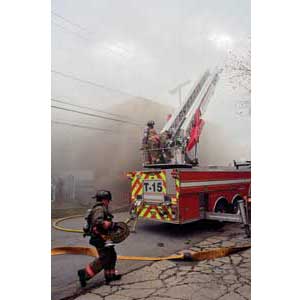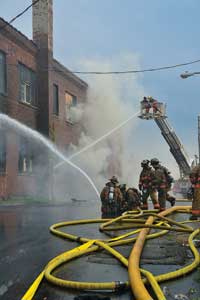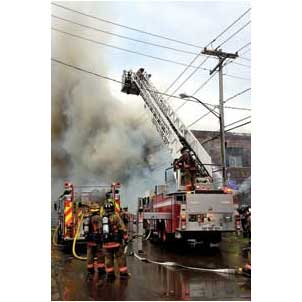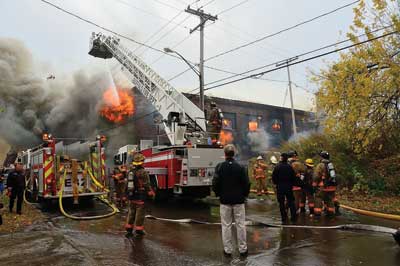 |
| (1) Members set up to use a large-caliber stream from an aerial ladder as another member brings large-diameter hose to supply the water. (Photos by Kevin Brautlacht.) |
By Michael M. Dugan
Firefighters from the Buffalo (NY) Fire Department were kept busy when a fire erupted in a 30- × 120-foot two-story brick warehouse. First-arriving units reported fire showing from windows on the exposure four side of the building. Two businesses were operating in the building at the time of the fire; both involved automobile repair and bodywork. They were the only reported occupants of the structure, and they reported that all of their people were out of the structure. The incident commander (IC) saw the size of the structure and indications of possible ongoing renovations on the second floor. The building was an old factory—most likely of a heavy mill-type construction with open floor areas or new dividing walls, which may be the cheapest construction possible. Taking all these factors into account, as well as the location and amount of smoke, the IC was forced to make some quick attack decisions and went with an exterior defensive attack as the attack strategy for this fire.
 |
| (2) Members operate a portable large-caliber stream. The unit initially was in the collapse zone and was repositioned for safety after the fire gained significant headway. |
You can see in the photos that the second-floor windows appear to have been replaced. The job does not look completed or, if it was completed, does not appear to be a job well done. The windows are smaller than their openings, and the space appears to have been filled in with plywood sheathing. This might indicate the building owner ran out of money or stopped interior renovations. It also might indicate that the owner was trying to make the second floor into residential living spaces. Either way, this is the indication of a possible problem for interior operating forces. The lack of completion of the window would lead us to believe that the interior walls and door might not be in place, allowing the fire to gain headway in an uncompartmented area. This might be dangerous for interior forces. Mixed construction types always lead to confusion for members: Is it mill-type construction or new lightweight building material? If you are not sure, always consider it to be the more hazardous type of construction, and be mindful that the construction was completed improperly.
 |
| (3) The windows on one side of the building fill the entire window opening, but the windows on the other visible exposure do not fill the space, indicating they were not well-constructed or installed. |
The smoke conditions indicated that the fire was deep seated and possibly had time to gain significant headway within the structure. The smoke was visible in the street and showing from many parts of the building. That indicated the fire intensified because it was not seen or reported quickly. In a partially occupied or vacant structure, the report of the fire to dispatch is usually delayed because no one is inside the structure to report the smoke or fire. The fire most likely was on two floors on arrival because of openings in the floors from construction and the time the fire had been burning.
 |
| (4) Changes in the smoke condition indicate that the fire is impacting a major portion of the building. |
Another issue at this fire was overhead electrical wires (visible in the photos), which included electric, cable, and telephone wires. The electric in these lines should have been shut down to protect the members operating nearby. The other issue is if one of the electric lines fails from exposure to fire and heat and comes in contact with the cable or telephone line, the fire could spread if these lines become charged. Every department should have emergency contact with the local utility company to ensure the electric is shut down as soon as possible.
 |
| (5) The fire is showing out the windows on the second floor. You can see the replacement windows along with the material with which they were installed failing. |
Since the IC went with a defensive attack, he directed units to set up outside of the collapse zone with master streams and portable large-caliber devices to get the maximum amount of water into the building from an area of safety. Keep in mind that you can reposition these devices; the IC moved the tower ladder at a corner of the structure farther back from the structure later in the fire because of the possibility of collapse.
 |
| (6) The tower ladder is redeployed after repositioning. The initial collapse has occurred, and the second-floor walls are gone. |
After the tower ladder was repositioned, a collapse occurred. No one was hurt, and no fire department equipment was damaged.
MICHAEL M. DUGAN is a 27-year veteran of the Fire Department of New York, where he served as captain of Ladder Company 123 before retiring in 2012. As a lieutenant, he served in Ladder Company 42 and was a firefighter in Ladder Company 43. He has been involved with the fire service for 39 years.
Fire Engineering Archives

